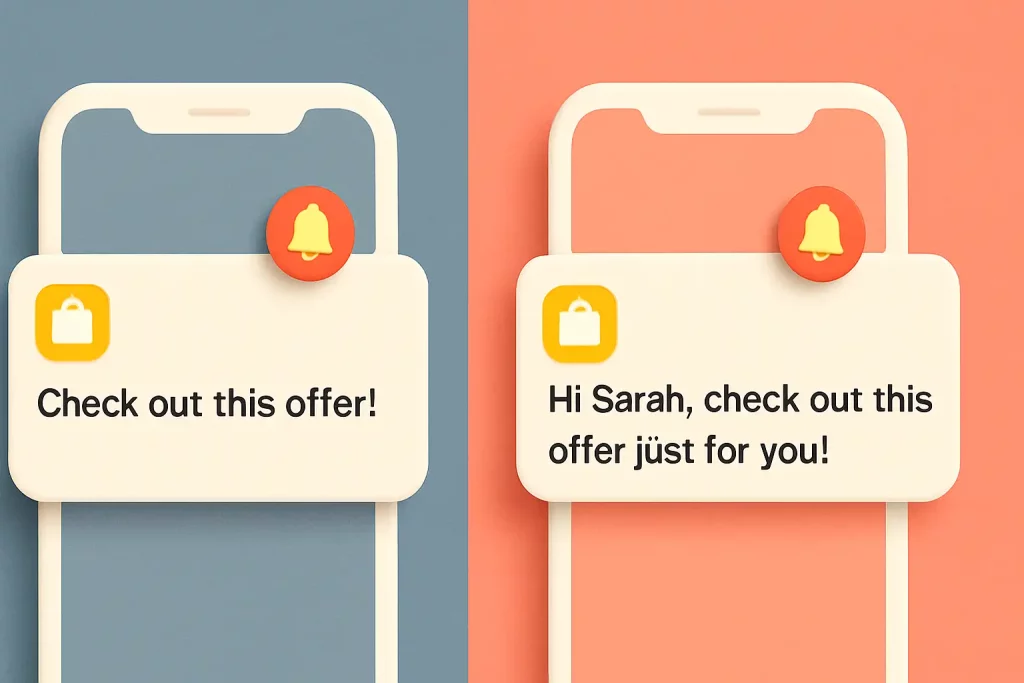In the crowded world of e-commerce, grabbing your customers’ attention is harder than ever. Email marketing is becoming saturated, and social media algorithms are constantly shifting. But there’s a powerful, often overlooked channel that can dramatically boost engagement and conversions: push notifications. However, generic, one-size-fits-all notifications are a missed opportunity. This article explores the power of personalization in crafting push notifications that truly resonate with your audience, driving higher engagement and ultimately, increased revenue.
Why Personalization Matters
Generic push notifications often end up ignored or even worse, marked as spam. Customers are bombarded with irrelevant messages daily. To cut through the noise, you need to deliver personalized messages that are timely, relevant, and offer value. Personalization isn’t just a nice-to-have; it’s a necessity for effective push notification marketing. It demonstrates that you understand your customers’ individual needs and preferences, fostering a stronger connection and driving loyalty. This translates directly to higher click-through rates, increased conversions, and improved customer retention.
Segmenting Your Audience
Effective personalization starts with segmentation. Instead of blasting the same message to your entire customer base, divide your audience into smaller, more homogenous groups based on shared characteristics. This could include:
- Purchase history: Segment by past purchases, product categories, or spending habits.
- Browsing behavior: Track products viewed, abandoned carts, or time spent on specific pages.
- Demographics: Leverage data such as location, age, or gender (if collected ethically and transparently).
- Engagement level: Segment based on past interactions with your push notifications.
By understanding these segments, you can tailor your messages to their specific interests and needs, significantly improving the relevance and effectiveness of your campaigns.
Using Customer Data Effectively
Leveraging customer data ethically and responsibly is crucial. Ensure you have a clear privacy policy and obtain explicit consent before collecting and using any personal information. Once you have the data, utilize it strategically. For example:
- Abandoned cart recovery: Send personalized reminders about items left in the cart, highlighting the specific products and offering a limited-time discount.
- Product recommendations: Suggest products similar to past purchases or items browsed on your site.
- Exclusive offers: Provide personalized discounts or promotions based on purchase history or engagement level.
- Birthday greetings: Send a personalized message and offer a special birthday discount.
Remember, the goal is to provide value to your customers, not to bombard them with irrelevant promotions.
Crafting Compelling Personalized Messages
The message itself is equally important. A personalized notification shouldn’t just mention the customer’s name; it should reflect their specific interests and needs. Use dynamic content to insert personalized information, such as:
- Product names: “Don’t forget about the [Product Name] you left in your cart!”
- Customer names: “Hi [Customer Name], we’ve got a special offer just for you!”
- Discount codes: “Enjoy [Discount Percentage]% off your next purchase with code [Discount Code]!”
Keep your messages concise, clear, and action-oriented. Use strong calls to action that encourage immediate engagement.
A/B Testing for Optimization
Don’t assume what works best. A/B testing is essential for optimizing your personalized push notifications. Test different segments, messages, calls to action, and even the timing of your notifications to determine what resonates most effectively with your audience. Track key metrics, such as click-through rates, conversion rates, and unsubscribes, to identify what strategies yield the best results.
Examples of Personalized Push Notifications
Let’s look at a few examples. Instead of a generic message like “New products arrived!”, you could send personalized messages like:
- “Hey [Customer Name], check out the new arrivals in your favorite category: [Category Name]!”
- “[Customer Name], we noticed you viewed the [Product Name]. It’s now on sale!”
- “[Customer Name], you haven’t completed your order. Here’s a reminder: [Order Summary]”
These examples highlight how specific details can make all the difference. The key is creating messages that feel relevant, timely, and individually catered to the customer’s interests.
Conclusion: Driving Engagement with Personalized Messages
Personalization is no longer a luxury; it’s a necessity for success in today’s competitive e-commerce landscape. By segmenting your audience, leveraging customer data effectively, and crafting compelling personalized messages, you can significantly improve the engagement and conversion rates of your push notification campaigns. Remember to continuously A/B test and refine your approach to optimize your results. By focusing on providing value and building stronger relationships with your customers, you can unlock the full potential of push notifications and drive significant growth for your Shopify store.

